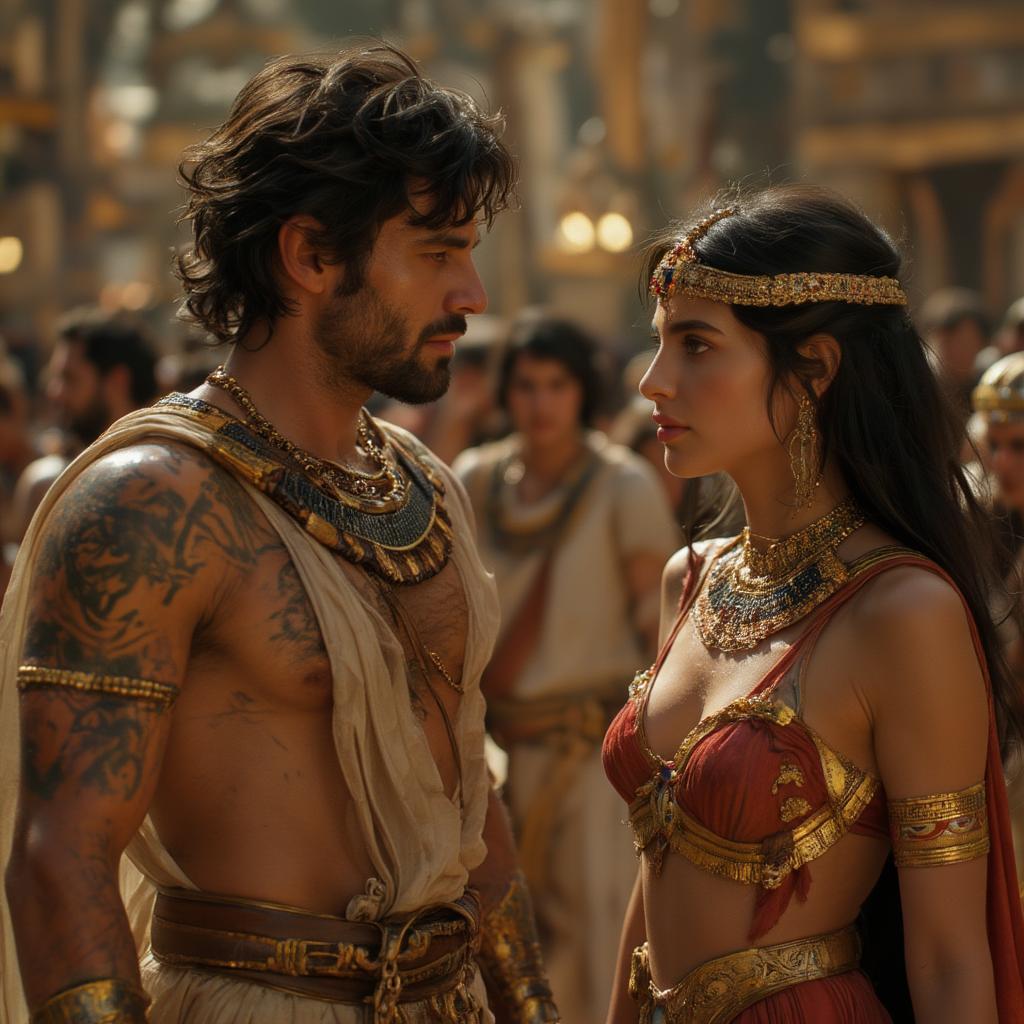The question of whether Moses loved Nefertari is a fascinating one, sparking curiosity and debate among history enthusiasts and scholars alike. While the popular image often depicts a romantic connection, the historical reality is far more nuanced and complex. Let’s delve into the available evidence and explore the possibilities surrounding this intriguing query.
Moses and Nefertari: A Love Story or a Historical Inaccuracy?
The notion of a romantic relationship between Moses and Nefertari is largely a product of fictional portrayals, most notably the 1956 film “The Ten Commandments.” This cinematic depiction took creative liberties, weaving a love triangle involving Moses, Nefertari, and Ramses II. However, there’s no historical basis to support this narrative. In fact, the timelines and historical accounts don’t align to allow for such a relationship.
 Moses and Nefertari in Film
Moses and Nefertari in Film
Examining the Historical Timeline and Evidence
Historians place Moses’s life during the reign of either Seti I or Ramses II. While Nefertari was a prominent queen during the reign of Ramses II, there’s no historical documentation or archaeological evidence suggesting any interaction between her and Moses. The biblical narrative focuses on Moses’s role in leading the Israelites out of slavery, with no mention of a romantic involvement with an Egyptian royal.
Was Nefertari even alive during Moses’s time?
While some debate exists about the exact timing of events, it’s generally accepted that Nefertari lived during the reign of Ramses II, the pharaoh most commonly associated with the Exodus story. Therefore, it’s plausible that they were contemporaries, though no evidence supports their paths crossing.
The Power of Fictionalized Narratives
The enduring image of Moses and Nefertari as lovers speaks to the power of fictionalized narratives to capture public imagination. While historically inaccurate, these portrayals have contributed to a romanticized vision of the past. It’s essential to differentiate between artistic interpretations and historical accuracy when exploring such topics.
Why is the love story so popular?
The appeal of a forbidden love story between individuals from opposing sides of a significant historical event is undeniable. This narrative trope adds an element of drama and intrigue, making the story more compelling for a wider audience.
Separating Fact from Fiction: The Importance of Historical Accuracy
While fictional accounts can be entertaining and thought-provoking, it’s crucial to ground our understanding of historical figures and events in reliable sources and evidence. The story of Moses is a significant one for both religious and historical contexts. Maintaining accuracy is essential for preserving the integrity of these narratives.
Conclusion: Did Moses Love Nefertari? The Verdict
While the idea of a romantic relationship between Moses and Nefertari is a compelling narrative element in fiction, historical evidence doesn’t support this claim. It’s crucial to differentiate between artistic license and historical accuracy when exploring such topics. The story of Moses and the Exodus remains a powerful and important one, and understanding it within its proper historical context is vital.
FAQ
- Is there any historical evidence of a relationship between Moses and Nefertari? No, there is no historical or archaeological evidence to support a romantic relationship between them.
- Who was Nefertari? Nefertari was a prominent queen of Ramses II, known for her beauty and influence.
- During which pharaoh’s reign did Moses live? Historians believe Moses lived during the reign of either Seti I or Ramses II.
- Why do people associate Moses and Nefertari romantically? The association primarily stems from fictional portrayals, particularly the 1956 film “The Ten Commandments.”
- What is the importance of separating fact from fiction in history? Separating fact from fiction allows for a more accurate understanding of historical events and figures, preserving the integrity of the narrative.
- Where can I learn more about the historical Moses? Numerous scholarly books and articles explore the historical context of Moses and the Exodus.
- What is the significance of the Exodus story? The Exodus story holds profound religious and historical significance for Jewish and Christian traditions.
Need further assistance? Contact us at Email: contact@daiduongtranhba.com, Address: Michigan Ave, Suite 3100, Chicago, IL 60611, USA. Our customer care team is available 24/7.


